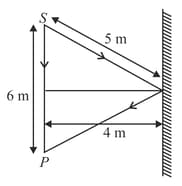EASY
Earn 100
In a stretch string, two waves of the same amplitude, each of travel in the same direction. The phase difference between the waves is and they interfere with each other. Find the amplitude of the resultant wave
Important Questions on Waves
EASY
The equations of two waves are given by :
These waves are simultaneously passing through a string. The amplitude of the resulting wave is :
EASY
MEDIUM
EASY
EASY
EASY
MEDIUM
EASY
(Acceleration due to gravity )
EASY
EASY
MEDIUM
MEDIUM
EASY
MEDIUM
MEDIUM
MEDIUM
MEDIUM
MEDIUM
EASY
HARD
A person standing at a distance of from a source of sound receives sound wave in two ways, one directly from the source and others after reflection from a rigid boundary as shown in the diagram. The maximum wavelength for which, the person will receive maximum sound intensity, is

